Mike Lawlor, Connecticut’s under secretary for Criminal Justice Policy and Planning, discusses Governor
Dannel P. Malloy’s Second Chance Society, a series of justice reforms (including dramatic changes to bail and
juvenile justice policies) that seek to reduce crime, lower spending on prisons, and help rebuild relationships between
criminal justice professionals and the communities they serve. This New Thinking podcast was recorded in Chicago
in April 2016 after Lawlor participated in a panel on “Jail Reduction and Public Safety” at Community Justice 2016.
 Mike Lawlor, second from left,
Mike Lawlor, second from left,
who is Connecticut’s under secretary for Criminal Justice Policy and Planning, participates in a panel on “Jail
Reduction and Public Safety” at Community Justice 2016.
MIKE LAWLOR:
People gradually buy into the fact that, after all, the whole point of the criminal justice system is to reduce crime,
and if that’s what’s happening, everybody’s doing a good job.
ROB WOLF: This is
Rob Wolf, Director of Communications at the Center for Court Innovation in Chicago at Community Justice 2016 where
there’s a lot going on, a lot of panels talking about justice reform, people from all around the country and
even around the world sharing ideas. One of those people with some interesting and cutting edge ideas is with me
right now. His name is Mike Lawlor. He is the Chief Criminal Justice Advisor to Connecticut Governor Dan Malloy,
and he just participated in a panel on jail reduction and public safety.
A lot of interesting
things are going on in Connecticut around justice reform, Mike, and I thought maybe you could explain a little bit
about what the governor’s agenda is. I understand it’s something called the Second Chance Society.
So what’s it all about?
LAWLOR: So yeah. My boss, Governor Malloy, talks extensively
about his goals for what he refers to as a “Second Chance Society.” And really that covers all of the ground
of the criminal justice reform initiatives we’re seeing around the country. He also articulates this with clear
goals, and goal number one is to reduce crime. Goal number two is to reduce spending, and goal number three is to
restore confidence in the criminal justice system, confidence among victims of crime who often come away thinking
that they did not get justice, confidence among African Americans and Latinos who thinks the system is just not fair
to them, and confidence among all citizens who see, every day, these examples of wrongful convictions or corruption
or misconduct by police or prosecutors or probation officers or corrections officers or even judges sometimes even
state legislators and governors, from time to time.
All of this undermines confidence in the criminal
justice system, so restoring people’s confidence and at the same time reducing crime is our goal. And we think
that by making a variety of changes across the board, we will continue to see a reduction in Connecticut’s crime
rate, which is at its lowest point in 48 years, and we’ll see we won’t have to spend as much money running
prisons, because for the immediate past 20 years or so we’ve spent more money running prisons in Connecticut
than we have running colleges, which is kind of crazy.
Gradually we can rebuild these relationships,
mainly between the criminal justice professionals and the community, and what you call community policing or something
else. It’s very important to build up that level of trust.
WOLF: Well those are really ambitious
goals. So what are the actual policies that are being proposed to achieve these goals to reduce crime, reduce spending
on the criminal justice system, and build confidence in the justice system?
LAWLOR: Okay, so let’s
start with what Governor Malloy has actually proposed this year, which is currently being considered by our state’s
legislature. It has two components. Number one is bail reform. Number two is raising the age of juvenile jurisdiction.
On the bail reform initiative, a number of states, most recently New Jersey, New Mexico, the New York Supreme
Court, have acknowledged that bail is a real problem. In other words, people sitting in jail because they can’t
afford to post what oftentimes are relatively low amounts of bail. The governor this year has proposed that we not
have money bail for people charged only with a misdemeanor, with an exception for cases involving violence, for example
family violence cases are often charged only as misdemeanors, but there is a very high risk that something bad is
going to happen.
He’s asked our state sentencing commission to look at a comprehensive reform
and report back next year so that potentially the legislature could enact comprehensive reform, as was the case in
New Jersey and New Mexico, Connecticut has a state constitution that guarantees bail to all offenders.
But many states, and the federal government have an option for what is know as preventive detention. So,
if there is an evidentiary showing that someone actually is a danger to the community, they can be held without bail
at all.
In Connecticut, at the moment, the governor’s concerned that the people who really
should be locked up pre-trial are not. The high-risk, career criminal gang-banger types, bcause they have frequent
flier points with the bail bondsmen and things like that, it’s easy for them to get out if they get arrested,
even if there’s kind of a high bail.
On the other hand of the spectrum are the people that
don’t need to be in jail, but they’re sitting there for months on end, waiting for their cases to get resolved
because they can’t come up with, in some cases, a few hundred dollars to get out the door.
So
that’s a big priority for us, and we think over time that will have a big impact on our jail population, but
more importantly …
WOLF: What’s the actual proposal?
LAWLOR: So the
proposal is no money bail for misdemeanors, and allowing all offenders who actually have a money bail that’s
been set for them, to have an option of posting 10% in cash that they would get back at the end of their case if
they show up for all their court appearances and that is the case in many states.
In Connecticut,
it’s actually an option that judges have pursuant to rules of court, but it’s not in statute, and we think
that by putting it into statute, it’ll be used more extensively.
Also, part of that proposal
is that whatever money is accrued, because this cash will be sitting in a savings account while the court process
plays out, all of that money that’s earned through interest will go to our legal aid operations in the state.
So it wouldn’t be going to the state. It would be going to help fund legal assistance for the poor. And any
money that is captured because people do not show up in court and we forfeit their money bail, that would also go
to legal aid.
So we’re trying to create a system that has no incentive to have higher bail
just to raise money, and at the same time, make it more of an option to actually get out, especially for people who
are poor.
WOLF: And you would presumably be saving money because fewer people would be held in
jail unnecessarily pre-adjudication.
LAWLOR: Right. We know about half the people in jail right
now in Connecticut, because they can’t post bail, are in there on relatively minor charges. So, now, obviously
on a case-by-case basis, there may be very high risk factors involved, but, in general, there’s way too many
people being held just because they can’t come up with enough money to post bail.
And we’d
like to get to the point where money bail is just not used at all. If you’re really dangerous, prosecutors would
have to put on an evidentiary showing, and you could potentially be held as a public safety measure, but the vast
majority of cases that really don’t meet those criteria would not sit in jail while their cases are pending.
WOLF: What if someone repeatedly doesn’t return to a court date?
LAWLOR: Well, the
proposal we have this year says that even if it’s a misdemeanor where no money bail is allowed, if the new misdemeanor
is in fact a failure to appear, that would allow for money bail to be set. But we know that, we’ve done a lot
of deep dives into our data that we have and the rate at which people fail to appear is actually higher if a bail
bondsman has posted bail for them.
Connecticut is the only state in the country— Now, keep in
mind we do not have any county courts, everything is run by the state. We have no county jails. We have no elected
prosecutors. We have no elected judges, and all courts are state courts, so it’s easier for us to make changes.
But we have the only statewide accredited pre-trial services agency in the country. It’s run in the judicial
branch. It’s very well staffed, and they are very good at sorting out offenders by risk and monitoring defendants
in the community with non-financial conditions of release.
So we have the infrastructure to really
expand this a lot, and to the extent that we can save jail bed days, we can save a lot of money and at the same time
get better outcomes, because all we know for sure is that putting somebody who’s really a low-risk, high-needs
person in jail, even for a short period of time, you’re actually increasing the odds that they’re going
to recidivate once they get out. So we’re trying to not do things that make it worse.
WOLF:
And it sounds like you have the infrastructure in place to do what bail supposedly does, which is to encourage someone
to come back to court, but you have a non-bail, non-monetary means to monitor compliance with that. And so, what
were some of the other …
LAWLOR: The juvenile … so I think the more ambitious goal the governor
has for this year is to raise the age of juvenile court jurisdiction from what it is now, 18, up to 21. So, if we
do it, we’ll be the first state in this country to do it. Other places do it. For example, Germany, which the
governor visited last year, you might have seen it on 60 Minutes. They did the piece a couple weeks ago.
In Germany, if you’re under 21 and you get arrested and go to court, the judge makes an immediate decision
whether the case will be handled pursuant to juvenile rules or adult rules and apparently 80% or 90% of the cases
are dealt with as a juvenile case, in effect.
So, the governor said, “Since we have gotten
some very good outcomes with our juvenile justice reforms that date back about 10 years, we’ve seen a dramatically
reduced number of young people getting arrested. We have historically low number of juveniles in juvenile detention
or in our juvenile prison-like facility, that if we’re getting these good outcomes by the earlier reforms, maybe
we can get those similar outcomes for 18, 19, and 20 year olds going forward.”
We’re
beginning a process where we’ll gradually phase this in. We’re also going to make changes in the way we
handle offenders under the age of 25. So, we want to have specialized parole and probation supervision for people
under 25 so that the officers involved, that’s their specialty, dealing with younger people. We’re going
to have a special correctional facility just for offenders under 25. We already have one for offenders under 21.
We want to have another one for the next age cohort there.
WOLF: And the rationale is because
they have different needs and are more amenable to rehabilitation?
LAWLOR: Exactly. And on top
of that, mixing a 21 year old kid whose got all sorts of problems that have landed him in jail with some 40 year
old career criminal guy’s probably not a good idea, and I think any person with common sense would understand
that that’s probably the case.
I don’t think it’s done by design that all these
people are mixed together in our prison system, but why not change it? We don’t have to build a new prison,
we just allocate one for the next age cohort and put in staff that specializes with that.
All
of this … the recent developments in brain science has really informed criminal justice policy planners like myself.
I think people now, for the first time, are realizing that you need to have a special approach to younger offenders,
meaning under 25.
If we are successful in getting some of these young people off this trajectory
towards career criminal status or lengthy terms of incarceration, we’ll need a lot fewer prison beds in this
country.
So, earlier I referred to our juvenile justice reforms that have already taken place
in Connecticut. First and foremost, Connecticut was one of three states in the country that used to treat 16 year
olds as adults all the time. So it was Connecticut, New York, and North Carolina. Back in 2007, the legislature voted
to increase the jurisdictional age up to 18, but to do it gradually, in increments, and establish a very robust planning
process to get there.
So we spent two years figuring out how to do this. Starting on January 1,
2010, we went from 16 to 17. Then on July 1, 2012, went from 17 to 18, and added all of that to the juvenile courts
and subtracted all of that from the adult courts.
It would be fair to say, “So how did that
turn out?” And now we know. It’s 2016, we have all the data. First of all, people had predicted, when we
did this, the juvenile courts would be overwhelmed with new cases, and actually today there are fewer cases coming
into the juvenile court than there were before because there’s are a lot fewer young people getting into trouble
that lead them to court in the first place.
Second, we know that we have an all-time low number
of kids in juvenile detention, and that has to do with a lot of different policy changes, not just raising the age.
But don’t forget, it used to be that on your 16th birthday you were automatically an adult. You never could
be in juvenile detention. Now we’ve added all 16 and 17 year olds, and even with that we’ve got a historic
low.
We have three juvenile detention facilities in our state. One of the three has closed. The
other two are about one-third full, and we’re probably going to close one of those two shortly. We’re closing
150 bed juvenile prison-like facility altogether. We’re just gonna close it. It’s down to 40 kids right
now.
So all of this has to do with fewer younger people getting into trouble and getting arrested
and ending up in court and ultimately incarcerated. We see that this effect is playing out now for already 18, 19,
20, 21, 22, 23 years. It’s like a trough moving through the arrest statistics.
And for example,
17 year-olds … the last year we have complete data for is 2014, there was 60%, six zero, 60% fewer arrests of 17
year-olds statewide in 2014 than there were in 2008, and it’s dropped in equal increments every single year.
In the adult system, we measure the number of kids in jail 18 to 21 years old who are actually incarcerated
on a particular day. That number has dropped from 2062 on January 1, 2008, down to 960 on January 1, 2016.
WOLF: You know the numbers right off the top of your head, don’t you?
LAWLOR: These
are important numbers.
WOLF: … recite them a lot. But lowering the age, it sounds like it’s
easier to do because the population is smaller, but it didn’t create fewer arrests. There are other factors.
LAWLOR: Right. Definitely. So, it’s the raising age, actually … we went up to 18, now we’re
proposing to go to 21.
See, juvenile court works differently and has a different triage mechanism
for new cases coming in. Not everybody ends up in front of a judge, and don’t have all the formal proceedings
with mandatory court dates, et cetera, which kind of sets up people for failure. You get charged with failure to
appear if you don’t show up on time, and go to your probation officers … there’s a lot of chutes and
ladders that kind of get you into trouble.
The juvenile system is much less formal. Much focused
on needs-assessment and hooking people up with appropriate interventions without an overlay of let’s say, court
appearances, a guilty plea, a probation officer. We are convinced that approaching young people differently will
get you better outcomes.
The reason I’m citing these statistics is, 10 years ago, when we
first started talking about this stuff people said, “If you make these changes, you’ll get these outcomes.”
So here we are, fast forward ten years. We’re getting those outcomes. Maybe it’s a complete coincidence,
but I don’t think so.
Other examples of changes have been in school systems themselves. We
know now that there’s a very high correlation between suspensions and expulsions, even in younger grades, and
ending up in prison down the road.
There’s an extensive study in the state of Texas, which
actually has very good data going back a long time, for every single kid in their public school system, and that’s
clearly shown that schools with the exact same type of kids and type of issues which tend to suspend and expel a
lot of kids, versus schools which are very similar but suspend very few kids, it’s the high suspension schools
that end up with the high incarceration rate down the road.
So, there’s something about not
ostracizing, jettisoning, younger people but trying to deal with their issues up front that means that they’ll
be much less likely to end up in the criminal justice system down the road. So it’s this kind of thinking, which
is really a complete re-thinking of schools, justice, service provision, everything else that gets us to where we
are today and sustains the momentum we hope to continue for the next few years.
The goal at the
end of the day is reducing crime. If crime’s going down, that’s good. If crime is going up, something is
wrong.
WOLF: And you said this, you thought, was the bigger task. The more challenging component
to implement of the Second Chance Society, the raising the age is this requiring how you have to persuade the legislature.
Are they on board?
LAWLOR: Well, it’s a lot easier to talk to legislators and ordinary citizens,
even journalists, editorial boards, about why we think this would be successful because we can cite the success of
earlier, similar initiatives.
And the process that the governor has recommended is gradual and
incremental with a lot of planning built into the front end. It’s really more about re-allocating resources,
because everything you add to the juvenile system, you subtract from the adult system, so we think it’s very
workable.
But people, appropriately, are apprehensive, skeptical, because it’s new. It’s
a completely different approach to this. It’s worth noting that we are making provisions to … it wouldn’t
be 100% of the people under 21 go to juvenile court. Obviously, murders and very serious crimes, very high-risk kids
of kids, there would be an option, with discretion, informed by specific standards or findings that need to be made,
to deal with a case in adult court.
So it’s not one-size-fits-all, at all. It’s very
focused on risk assessment, needs assessment, with the stated goal up front of reducing crime, reducing recidivism
among kids who are actually coming in to court.
We think, based on our experience, that just talking
about these things as the actual goals, talking about the fact that we now have the capability to measure all this
data, make it very transparent so everybody can see what’s going on, that affects behavior of everyone on the
front lines: the cops, the prosecutors, probation parole, corrections, everybody. They know what the goal is, they
know that you’re able to figure this stuff out, and I think people gradually buy into the fact that, after all,
the whole point of the criminal justice system, one would think, is to reduce crime. And if that’s what’s
happening, everybody’s doing a good job.
WOLF: Well, thanks for explaining all that, and
good luck with all your exciting stuff going on in Connecticut.
LAWLOR: Thank you.
WOLF:
I’ve been speaking with Mike Lawlor, who is Connecticut Governor Dan Malloy’s Chief of Criminal Justice,
well, the Chief Advisor to the governor, right?
LAWLOR: Policy stuff.
WOLF:
Your exact title is, Undersecretary, Criminal Justice Policy and Planning Division.
LAWLOR: That’s
the job. I’m a bureaucrat.
WOLF: Well, we need bureaucrats to get this done, right?
LAWLOR: There you go.
WOLF: I’m Rob Wolf, Director of Communications at the Center
for Court Innovation, and Mike and I have been speaking outside of the rooms where Community Justice 2016 is occurring
here at the Hilton in Chicago, where for two and a half days, people from around the country and even a few visitors
internationally have been discussing justice reform. To find out more about the Center for Court Innovation and about
justice reform, and about community justice, visit our website, www.courtinnovation.org. Thanks for listening.

 Our TOPPODCAST Picks
Our TOPPODCAST Picks  Stay Connected
Stay Connected





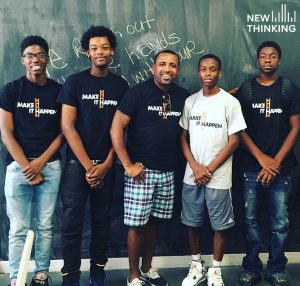
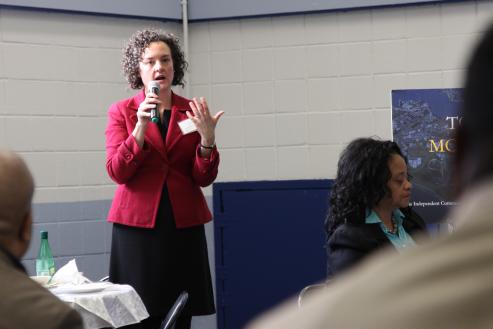
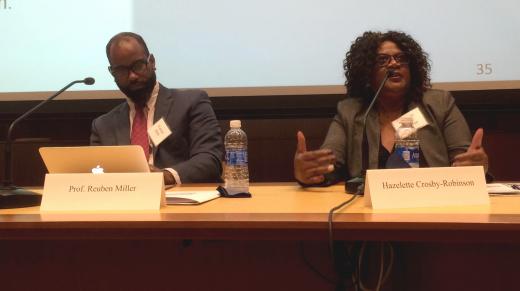 Reuben J. Miller,
Reuben J. Miller,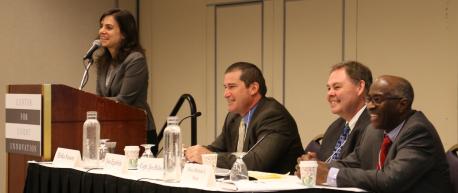 A panel on Restorative Justice at Community
A panel on Restorative Justice at Community
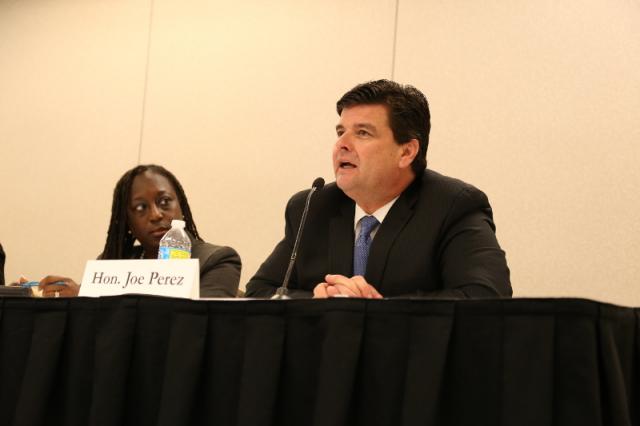 Judge
Judge.JPG) Kerry Walker of the Neighbourhood Justice Centre in Melbourne, Australia, discusses best practices
Kerry Walker of the Neighbourhood Justice Centre in Melbourne, Australia, discusses best practices.img_assist_custom-550x367.JPG) Deborah Barrows, program manager of Community Partners in Action, talks about
Deborah Barrows, program manager of Community Partners in Action, talks about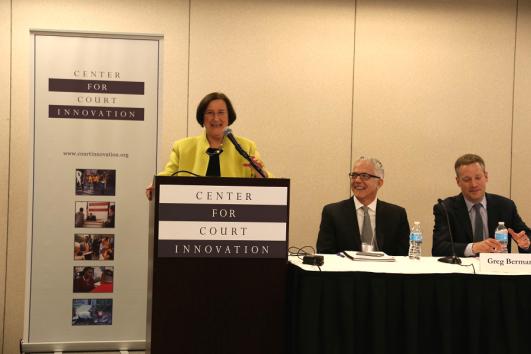 At Community Justice 2016: Above, Denise O’Donnell, director of the Bureau
At Community Justice 2016: Above, Denise O’Donnell, director of the Bureau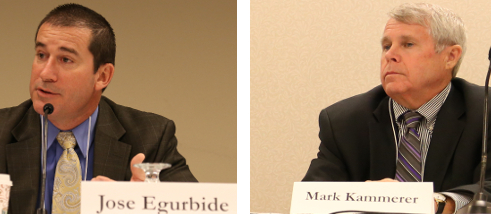
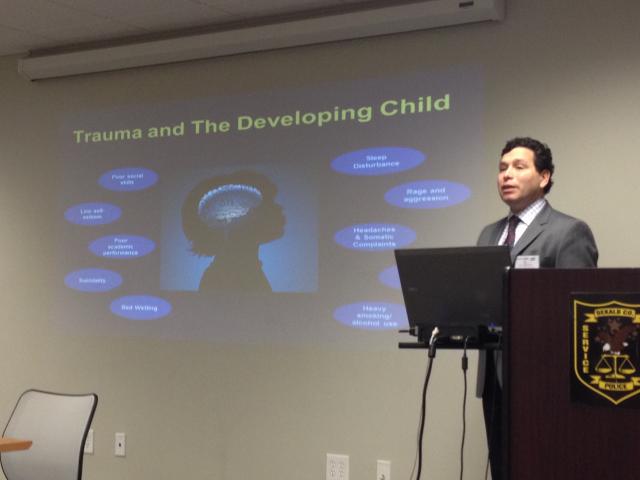
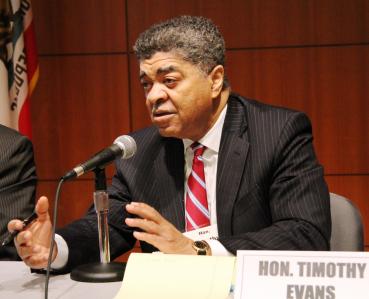 Chief
Chief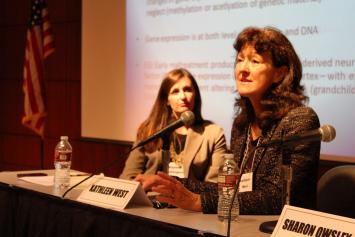 Kathleen West participates in a panel on linking defendants
Kathleen West participates in a panel on linking defendants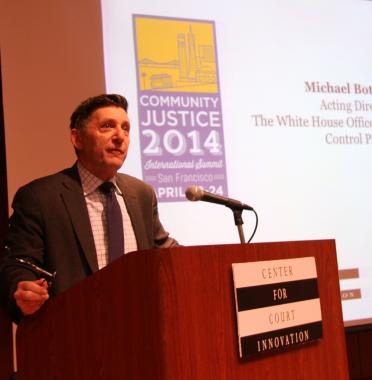 In keynote remarks at Community Justice 2014, Michael Botticelli discusses the
In keynote remarks at Community Justice 2014, Michael Botticelli discusses the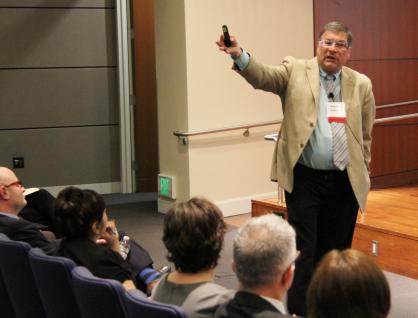 Edward J. Latessa
Edward J. Latessa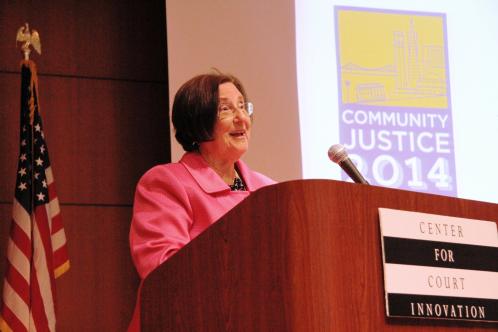 Denise
Denise David
David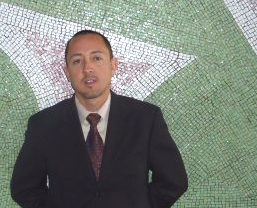 Camilo Cruz
Camilo Cruz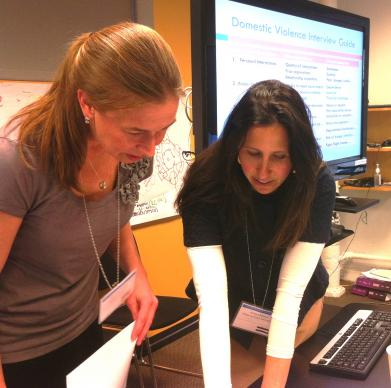 Kristine
Kristine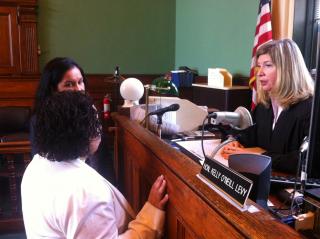 Judge Kelly O’Neill Levy discusses a case with her law clerk and resource
Judge Kelly O’Neill Levy discusses a case with her law clerk and resource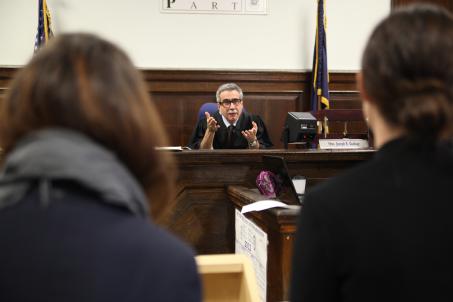 Kings County (N.Y.) Justice Joseph Gubbay presides over the Brooklyn pilot of
Kings County (N.Y.) Justice Joseph Gubbay presides over the Brooklyn pilot of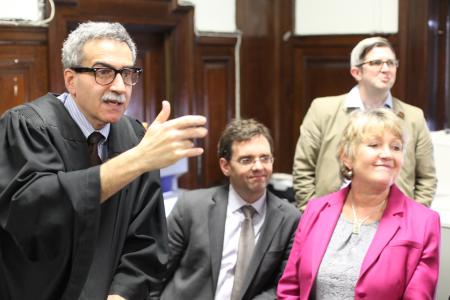 Judge Joseph Gubbay welcomes observers, including Chief
Judge Joseph Gubbay welcomes observers, including Chief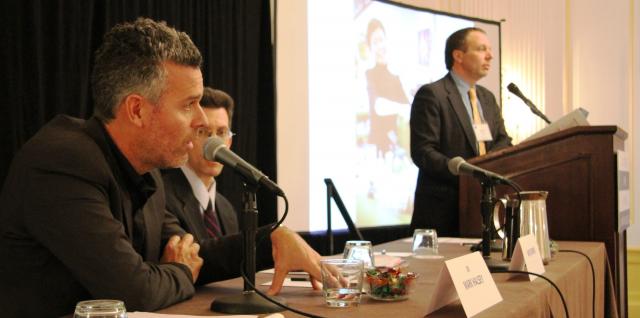 Associate Professor
Associate Professor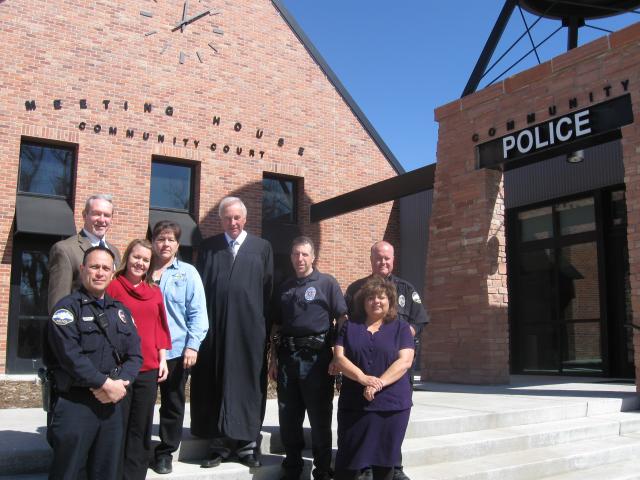 Jim Burack, third from right, says the new combined courthouse/police station
Jim Burack, third from right, says the new combined courthouse/police station




